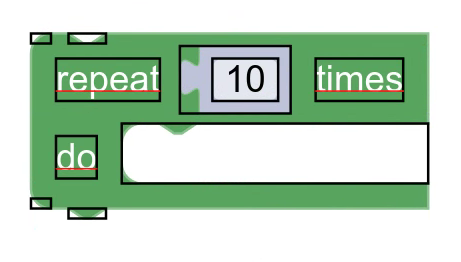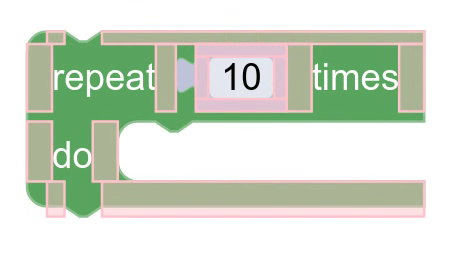Blockly จะย้ายไปอยู่กับมูลนิธิ Raspberry Pi ในวันที่ 10 พฤศจิกายน 2025 อ่านบล็อก
และคำถามที่พบบ่อย
องค์ประกอบ
จัดทุกอย่างให้เป็นระเบียบอยู่เสมอด้วยคอลเล็กชัน
บันทึกและจัดหมวดหมู่เนื้อหาตามค่ากำหนดของคุณ
ในระหว่างการวัด การบล็อกจะแบ่งออกเป็นแถวซึ่งมีองค์ประกอบที่ไม่ซ้อนทับกันและที่กั้นองค์ประกอบ
องค์ประกอบ
องค์ประกอบคือสิ่งที่มองเห็นได้ในบล็อก ตัวอย่างเช่น องค์ประกอบ
ที่แสดงถึง

แต่ละองค์ประกอบคือสี่เหลี่ยมผืนผ้าที่กำหนดขอบเขตของสิ่งที่มองเห็นได้ รวมถึงข้อมูลเพิ่มเติมบางส่วนที่เจาะจงสำหรับองค์ประกอบแต่ละประเภท
ขอบเขตขององค์ประกอบมักกำหนดโดยคลาสภายนอก (ซึ่งเป็นสิ่งที่แสดงถึง) ตัวอย่างเช่น องค์ประกอบช่องแสดงถึงช่อง และขนาดของช่องจะกำหนดตามเมธอด getSize ของช่อง
ที่กั้นองค์ประกอบ
พื้นที่สำหรับองค์ประกอบคือพื้นที่ว่างที่เชื่อมระหว่างองค์ประกอบในแถว

ขอบเขตของพื้นที่กั้นจะกำหนดโดยข้อมูลการแสดงผลระหว่างการวัด หลังจากวัดองค์ประกอบทั้งหมดของบล็อกแล้ว ข้อมูลการแสดงผลจะแทรกช่องว่างตามขนาดที่เลือกระหว่างองค์ประกอบต่างๆ ขนาดไม่จำเป็นต้องตรงกัน ขนาดต่างๆ มักแตกต่างกันขึ้นอยู่กับองค์ประกอบที่อยู่ด้านข้างของที่กั้นระยะ
เนื้อหาของหน้าเว็บนี้ได้รับอนุญาตภายใต้ใบอนุญาตที่ต้องระบุที่มาของครีเอทีฟคอมมอนส์ 4.0 และตัวอย่างโค้ดได้รับอนุญาตภายใต้ใบอนุญาต Apache 2.0 เว้นแต่จะระบุไว้เป็นอย่างอื่น โปรดดูรายละเอียดที่นโยบายเว็บไซต์ Google Developers Java เป็นเครื่องหมายการค้าจดทะเบียนของ Oracle และ/หรือบริษัทในเครือ
อัปเดตล่าสุด 2025-07-25 UTC
[null,null,["อัปเดตล่าสุด 2025-07-25 UTC"],[],["During the measurement phase, blocks are divided into rows with elements and spacers. Elements, such as fields, icons, connections, and corners, are represented by rectangles with specific data. Their sizes are dictated by external classes, like a field's `getSize` method. Element spacers are empty spaces inserted between elements by the render info, with varying sizes based on the adjacent elements. The render info determines spacer sizes after measuring all block elements.\n"]]



